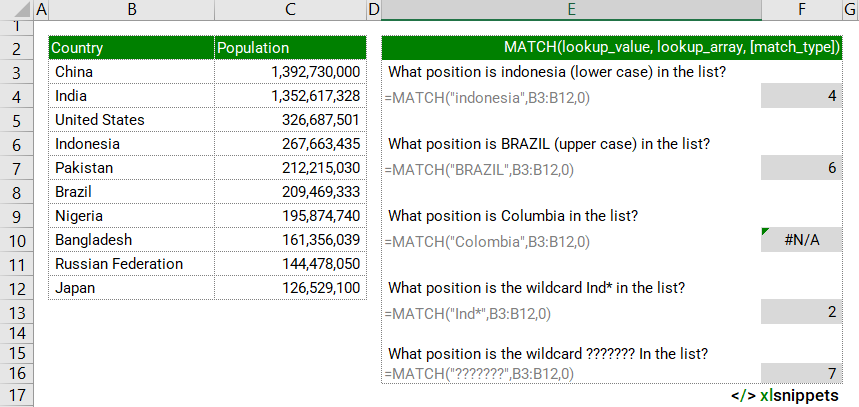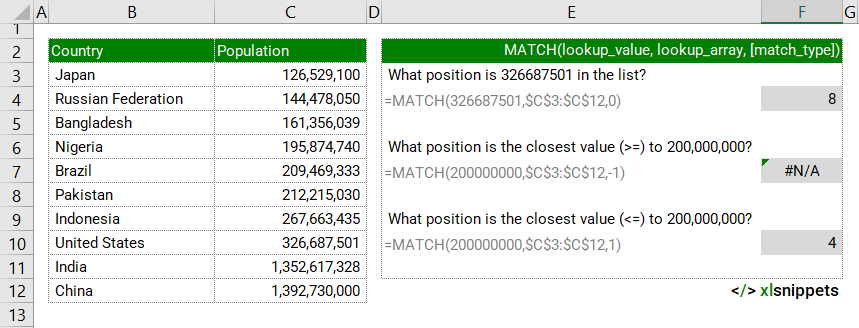Return the relative position of a specified item in a range
=MATCH(lookup_value, lookup_array, [match_type])
For Excel 365 subscribers, try using the new XMATCH function instead of MATCH. XMATCH works in any direction and returns exact matches by default.
MATCH returns the relative position of a specified item in a range. It defines 'what to match', 'where to search' and 'match type to return'.
Use MATCH to find the position of a value in a range instead of the value itself (e.g. in the row_num argument of the INDEX function.
MATCH and text values
In the examples below, the MATCH function is used to match country names to a list. The lookup_values are case insensitive. #N/A is returned for values not found in the list and wildcards (* ?) are accepted.
Use the MATCH function to return the relative position of a specified item in a range.

MATCH and numerical values
In the examples below, the MATCH function is used to match country populations to a list in ascending order. A match_type of 0 returns exact matches. -1 returns an exact match or next largest value but needs the list of numbers to be in descending order so returns the #N/A error in this instance. 1 returns an exact match or the next smallest value - the list of numbers is in the required ascending order.
Use the MATCH function to return the relative position of a specified number in a range.

Syntax
=MATCH(lookup_value, lookup_array, [match_type])
The MATCH function consists of at least 2 arguments:
- lookup_value. Required. The value to be matched.
- lookup_array. Required. A range of cells to be searched.
- match_type. Optional. 1, 0 or -1.
- 1 is default and finds the largest value that is less than or equal to the lookup_value. The values in the lookup_array must be in ascending order (e.g. A-Z, FALSE, TRUE, -2, -1, 0, 1, 2).
- 0 finds the first value that is an exact match to the lookup_value.
- -1 finds the smallest value that is greater than or equal to the lookup_value. The values in the lookup_array must be in descending order (e.g. Z-A, TRUE, FALSE, 2, 1, 0, -1, -2).
Try it now!
- Enter your formulas into the grey cells.
Scope
MATCH defines 'what to match', 'where to search' and 'match type to return'.
|
=MATCH("indonesia",B3:B12,0) || result is the position of the lookup_value "indonesia" in the lookup_array B3:B12. MATCH is case insensitive, not distinguishing between upper and lowercase letters. |
|
=MATCH(326687501,$C$3:$C$12,0) || result is the position of the lookup_value 326,687,501 in the lookup_array C3:C12. The #N/A error value is returned if no exact match (based on the optional match_type) is found. |
|
=MATCH(200000000,$C$3:$C$12,1) || result is the largest value from the lookup_array C3:C12 that is less than or equal to the lookup_value 200,000,000. The values in the lookup_array must be in ascending order. |
|
=MATCH(200000000,$C$3:$C$12,-1) || result is the smallest value from the lookup_array C3:C12 that is greater than or equal to the lookup_value 200,000,000. The values in the lookup_array must be in descending order. |
Caveats
- Excel 365 subscribers should try the new XMATCH function instead of MATCH. XMATCH works in any direction and returns exact matches by default.
- MATCH returns the position of the matched value, not the actual value itself.
- MATCH can be combined with the INDEX function to retrieve a value from a specific matched position. MATCH identifies the position of the value and INDEX returns the value at that position.
- lookup_value
- Can be a number, text, logical value or cell reference. Text strings can be up to 255 characters in length.
- MATCH does not distinguish between uppercase and lowercase.
- Wildcards (* ?) can be used in text strings. To find actual question marks (?) or asterisks (*), place a tilde (~) before the character.
- lookup_array
- Needs to be in ascending order when using the default match_type 1 (find the largest value that is less than or equal to the lookup_value).
- Can be in any order when using the match_type 0 (find the first value that is exactly equal to the lookup_value).
- Needs to be in descending order when using the match_type -1 (find the smallest value that is greater than or equal to the lookup_value).
- match_type
- match_type is optional and defaults to 1.
- MATCH returns the #N/A error if no match can be found. Use the IFNA function to trap and handle #N/A errors.
- MATCH returns the first match in the case of duplicates.
Common issues
- #N/A: lookup_value can not be matched in the lookup_array.
Related Functions
Functions Category



